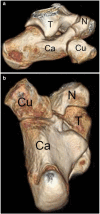Fracture through Pre-Existing Tarsal Coalition: A Narrative Review
- PMID: 36670623
- PMCID: PMC9857168
- DOI: 10.3390/children10010072
Fracture through Pre-Existing Tarsal Coalition: A Narrative Review
Abstract
Tarsal coalitions are abnormal fibrous or bony connections between the tarsal bones of the foot. While not always symptomatic, coalitions can cause pain, alterations in forefoot and hindfoot morphology, and alterations in foot and ankle biomechanics. Previous research has described the association of tarsal coalitions with fractures of the lower extremity. Multiple reports of acute fracture in the presence of tarsal coalition have been presented, as have reports of stress fractures of the foot and ankle with concomitant coalition, insidious in onset and thought to be related to aberrancies in foot and ankle biomechanics. The purpose of this review is to discuss the biomechanics seen in tarsal coalitions and to describe reports of fracture occurring concomitantly with tarsal coalitions. We will discuss diagnostic options and treatment approaches in the setting of fracture with preexisting tarsal coalition.
Keywords: ankle; biomechanics; calcaneonavicular coalitions; foot; stress fracture; talocalcaneal coalition; tarsal coalition.
Conflict of interest statement
The authors declare no conflict of interest.
Figures



References
-
- Graham J.M., Jr., Braddock S.R., Mortier G.R., Lachman R., Van Dop C., Jabs E.W. Syndrome of coronal craniosynostosis with brachydactyly and carpal/tarsal coalition due to Pro250Arg mutation in FGFR3 gene. Am. J. Med. Genet. 1998;77:322–329. doi: 10.1002/(SICI)1096-8628(19980526)77:4<322::AID-AJMG14>3.0.CO;2-K. - DOI - PubMed
Publication types
LinkOut - more resources
Full Text Sources

